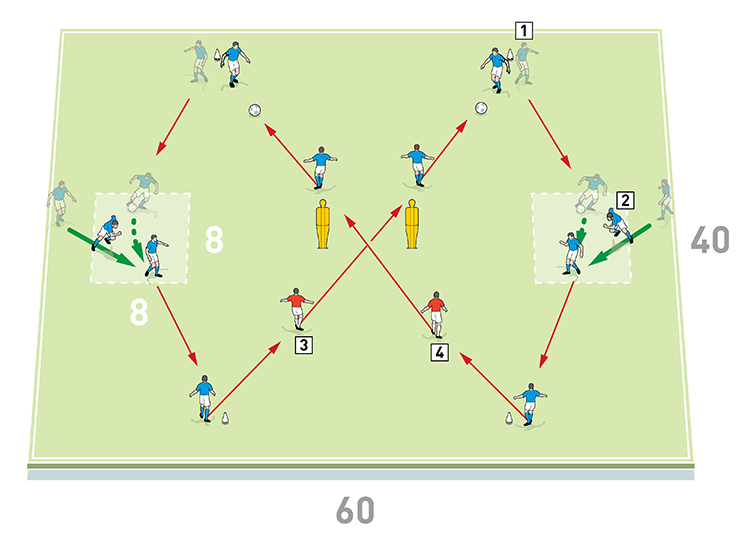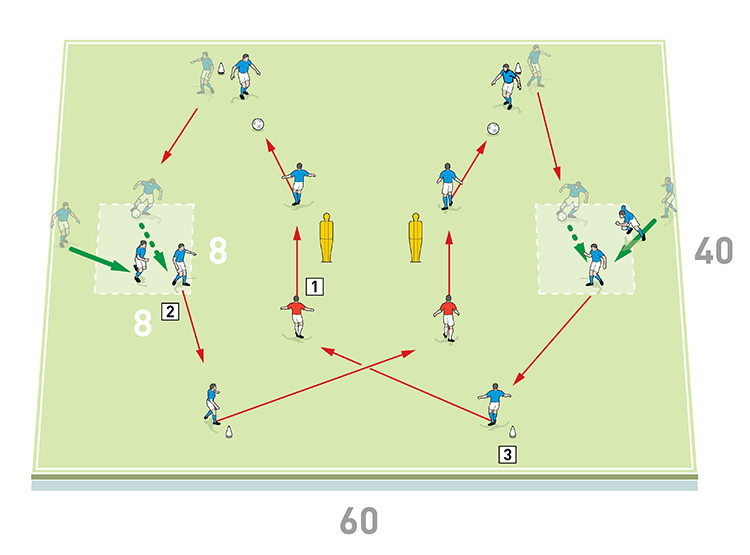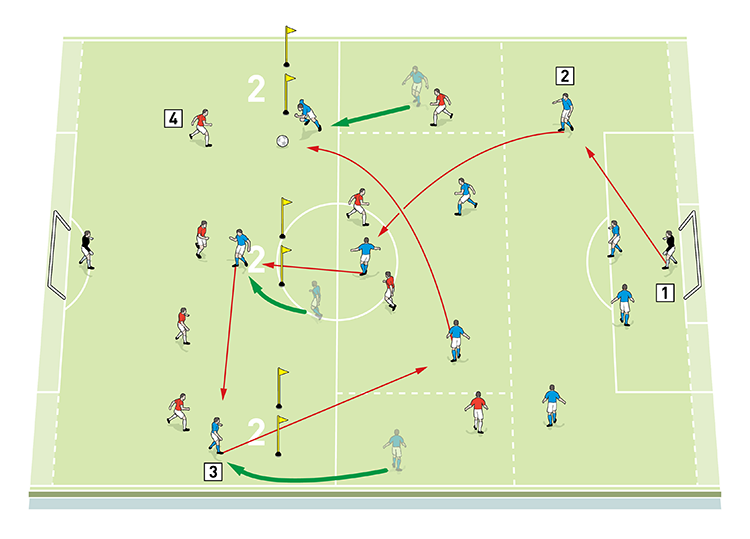You are viewing 1 of your 1 free articles
Switching play with penetration
This session is about changing the point of attack. It shows players the different ways we can do this, allowing the team to attack at pace once we have created overloads.
| Area | Up to three quarters of a pitch |
| Equipment | Balls, bibs, cones, 2 mannequins, 2 full size goals |
| No. of Players | Up to 18 players + 2 goalkeepers |
| Session Time |
Switching play drill 1: 10mins, Switching play drill 2: 10mins, Switching play 10v8: 10mins |
This session is about changing the point of attack. It shows players the different ways we can do this, allowing the team to attack at pace once we have created overloads.
It’s a good session because it gives players plenty of opportunities to practise the building blocks of the tactic within the passing exercise and then they will have a chance to put what they’ve learnt into a function of play where the decision-making elements of the game become a part of it.
We run the session at least once a month but we try to add slight variations or progressions each time, to keep the players engaged.
What do I get the players to do?
Switching play drill 1
We set up an area of 60x40 yards with two 8x8-yard boxes positioned as shown [1]. Between the boxes are a pair of mannequins, representing opposition midfielders. We’re using 12 outfield players, split into 10 blue passing players and two red central midfielders.
1

2. A pressing player tries to tag the receiving player in the box to put pressure on the pass
3. The focus is on moving the ball through the two red central midfielders, who switch the play
4. Passes through midfield should go close to the mannequins, who represent the danger of opposition midfielders
This is a passing drill and two balls are on the go at the same time. Play starts simultaneously from the two players at the top, with each passing to the player in the nearest box, one in a clockwise direction and the other anti-clockwise. A player outside each box tries to tag the receiving player to put pressure on the pass and add intensity to the move.
Each receiving player should pass the ball to the next player in the sequence and both balls are moved around the circuit in a figure of eight. The focus is on moving the ball through the two red central midfielders, who should switch the play diagonally through the centre near to the mannequins. We play this for 10 minutes.
Switching play drill 2
Using the same set-up as before, players run essentially the same passing drill but play goes through midfield in a different way, with the red midfielders now keeping the ball away from the mannequins, as shown [2]. We play for 10 minutes.
2

2. It’s an unopposed drill but players should still check over their shoulders to show they are aware of what’s happening around them
3. It’s important that players use the correct weight and angle of pass, or the drill won’t work
What do I get the players to do next?
Switching play 10v8
For this switching play exercise, we set up on three quarters of a pitch, with a goal and a goalkeeper at each end. We mark out three midfield zones, as shown [3a], but these are just visual prompts for the players. We also create three gates in the defending half of the pitch.
3a

2. Before being allowed to attempt a shot at goal, the attacking team must pass through the gates twice, forcing them to switch play
3. The ball can go through the gates in either direction to count
4. The red team of 8 are not limited to defending the gates, they should defend as normal
We’re using 18 outfield players, divided into an attacking team of 10 who play against a defending team of eight, set up as if both teams were playing in a 4-2-3-1 formation.
Before being allowed to attempt a shot at goal, the attacking team must pass the ball through two of the gates, forcing the attackers to switch the play regularly. The ball can pass through the gates from either direction to count.
To stop the attackers scoring, the defending team should defend as normal and should not focus on just defending the gates. They can drop deeper or press and it is up to the attackers to recognise the tactic adopted by the defenders and adapt their play accordingly.
Once the attackers have passed the ball through the gates twice, the attack becomes a 5v3 situation, with the remaining players becoming passive, as shown [3b]. Only three of the defending team’s back four remain live, while just five of the attackers are active, but this must include a wide player or an attacking full back to capitalise on the switch.
3b

2. To defend the attack, only three of the reds remain active, making it a 5v3 attack. The remaining players are now passive
3. The blues must attempt to score
How do I progress the session?
To progress the 10v8 activity we can make it tougher for the attackers by adding an extra player to the defending team, making it 10v9. We could also limit the number of touches allowed in the central zone.
What are the key things to look out for?
The key things to look out for technically are that players are checking over their shoulders. They should also use the correct weight and angle of pass, and demonstrate that they can receive the ball.
Tactically it’s important that teams can learn how to switch the point of attack through different areas of the pitch – across the back, through midfield and via the strikers. Being able to make well-timed support runs is also vital.
What are the typical mistakes players might make and how do I avoid them?
In the passing section of the session, a common mistake is that the central midfielders do not check over their shoulders enough and therefore are not aware of what is around them, which either slows down a switch of play or will see them lose possession, due to poor awareness. We try to correct this by having coaches holding up different coloured bibs, which the player in question has to call out.
Related Files
Editor's Picks
Using the goalkeeper in build-up play
Pressing principles
Intensive boxes drill with goals
Penetrating the final third
Creating and finishing
My philosophy
Pressing initiation
Compact team movement
Defensive organisation
Coaches' Testimonials

Alan Pardew

Arsène Wenger

Brendan Rodgers

Carlos Carvalhal

José Mourinho

Jürgen Klopp

Pep Guardiola

Roy Hodgson

Sir Alex Ferguson

Steven Gerrard
Related
Coaches' Testimonials

Gerald Kearney, Downtown Las Vegas Soccer Club

Paul Butler, Florida, USA

Rick Shields, Springboro, USA

Tony Green, Pierrefonds Titans, Quebec, Canada
Join the world's leading coaches and managers and discover for yourself one of the best kept secrets in coaching. No other training tool on the planet is written or read by the calibre of names you’ll find in Elite Soccer.
In a recent survey 92% of subscribers said Elite Soccer makes them more confident, 89% said it makes them a more effective coach and 91% said it makes them more inspired.
Get Monthly Inspiration
All the latest techniques and approaches
Since 2010 Elite Soccer has given subscribers exclusive insight into the training ground practices of the world’s best coaches. Published in partnership with the League Managers Association we have unparalleled access to the leading lights in the English leagues, as well as a host of international managers.
Elite Soccer exclusively features sessions written by the coaches themselves. There are no observed sessions and no sessions “in the style of”, just first-hand advice delivered direct to you from the coach.









